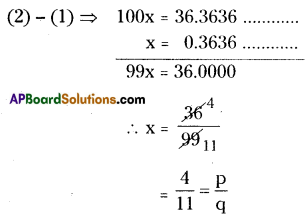AP State Syllabus AP Board 8th Class Maths Solutions Chapter 1 Rational Numbers Ex 1.3 Textbook Questions and Answers.
AP State Syllabus 8th Class Maths Solutions 1st Lesson Rational Numbers Exercise 1.3
![]()
Question 1.
Express each of the following decimal in the [latex]\frac{p}{q}[/latex] form.
(i) 0.57 (ii) 0.176 (iii) 1.00001 (iv) 25.125
Solution:
(i) 0.57 = [latex]\frac{57}{100}[/latex] (∵ two digits are there after the decimal poing)
(ii) 0.176 = [latex]\frac{176}{1000}[/latex]
(iii) 1.00001 = [latex]\frac{100001}{100000}[/latex]
(iv) 25.125 = [latex]\frac{25125}{1000}[/latex]
Question 2.
Express each of the following decimals in the rational form [latex]\frac{p}{q}[/latex]
(1) [latex]0 . \overline{9}[/latex]
(ii) [latex]0 . \overline{57}[/latex]
(iii) [latex]0 .7 \overline{29}[/latex]
(iv) [latex]12.2 \overline{8}[/latex]
Solution:
(i) [latex]0 . \overline{9}[/latex]
Let x = [latex]0 . \overline{9}[/latex]
⇒ x = 0.999 ………………. (1)
Here periodicity is 1. So, equation (1) should be multiplied both sides with
= 10 × x = 10 × 0.999
10 x = 9.999 ………….. (2)
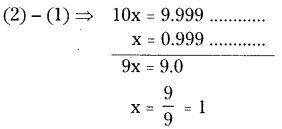
[latex]0 . \overline{9}[/latex] = 1
![]()
Second Method:
[latex]0 . \overline{9}=0+\overline{9}=0+\frac{9}{9}[/latex]
= 0 + 1 = 1
(ii) [latex]0 . \overline{57}[/latex]
x = [latex]0 . \overline{57}[/latex] ⇒ x = 0.5757…………(1)
Here periodicity is 2. So, we should multiply with 100
⇒ 100 × x = 100 x 0.5757 …………..
100 × =57.57 ……………………. (2)

(iii) [latex]0 .7 \overline{29}[/latex]
x = [latex]0 .7 \overline{29}[/latex]
x = [latex]0 .7 \overline{29}[/latex] ⇒ x = 0.7979…………(1)
Here periodicity is 2. So, equation (1) should multiply with 100
⇒ 100 × x = 100 × 0.72929 …………..
100 × = 72.929 …………………… (2)
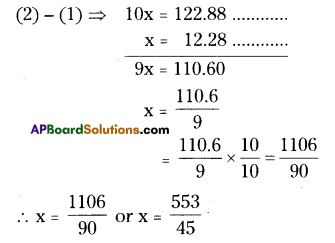
![]()
(iv) [latex]12.2 \overline{8}[/latex]
x = (iv) [latex]12.2 \overline{8}[/latex]
⇒ x = 12.288 ………..(1)
Here periodicity is 1. So, equation (1) should multiply with 10
⇒ 100 × x = 100 × 12.288 …………..
10 x = 122.888 …………………… (2)
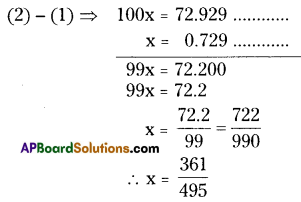
Question 3.
Find(x + y) ÷ (x – y) if
(i) x = [latex]\frac{5}{2}[/latex], y = [latex]-\frac{3}{4}[/latex]
(ii) x = [latex]\frac{1}{4}[/latex], y = [latex]\frac{3}{2}[/latex]
Solution:
If x = [latex]\frac{5}{2}[/latex], y = [latex]-\frac{3}{4}[/latex] then

ii) x = [latex]\frac{1}{4}[/latex], y = [latex]\frac{3}{2}[/latex]
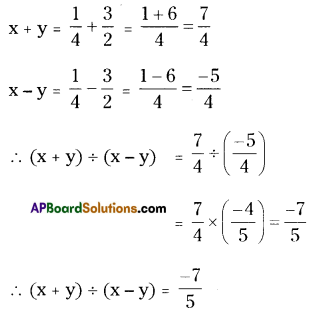
![]()
Question 4.
Divide the sum of [latex]-\frac{13}{5}[/latex] and [latex]\frac{12}{7}[/latex] by the product of [latex]-\frac{13}{7}[/latex] and [latex]-\frac{1}{2}[/latex]
Solution:
Sum of [latex]-\frac{13}{5}[/latex] and [latex]\frac{12}{7}[/latex]
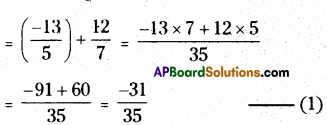
the product of [latex]-\frac{13}{7}[/latex] and [latex]-\frac{1}{2}[/latex]
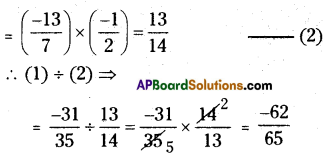
Question 5.
If [latex]\frac{2}{5}[/latex] of a number exceeds [latex]\frac{1}{7}[/latex] of the same number by 36. Find the number.
Solution:
Let the number be ‘x’ say.
[latex]\frac{2}{5}[/latex] part of x = [latex]\frac{2}{5}[/latex] × x = [latex]\frac{2x}{5}[/latex]
[latex]\frac{1}{7}[/latex] part of x = [latex]\frac{1}{7}[/latex] × x = [latex]\frac{x}{7}[/latex]
∴ According to the sum,
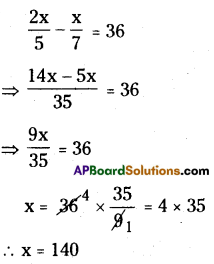
Question 6.
Two pieces of lengths 2[latex]\frac{2}{5}[/latex] m and 3[latex]\frac{3}{10}[/latex] mare cut off from a rope 11 m long. What is the length of the remaining rope?
Soltuion:
The length of the remaining rope
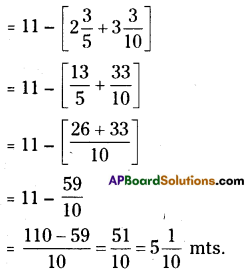
∴ The length of remaining rope
= 5[latex]\frac{1}{10}[/latex] mts.
![]()
Question 7.
The cost of 7[latex]\frac{2}{3}[/latex] meters of cloth is ₹12[latex]\frac{3}{4}[/latex] . Find the cost per metre.
Solution:
The cost of 7[latex]\frac{2}{3}[/latex] mts ([latex]\frac{23}{3}[/latex] mts ) of cloth
= ₹ [latex]12 \frac{3}{4}[/latex] = ₹ [latex]\frac{51}{4}[/latex]
∴ The cost of 1m cloth
= [latex]\frac{51}{4} \div \frac{23}{3}=\frac{51}{4} \times \frac{3}{23}=\frac{153}{92}[/latex] = ₹ 1.66
Question 8.
Find the area of a rectangular park which is 18[latex]\frac{3}{5}[/latex]m long and 8[latex]\frac{2}{3}[/latex] in broad.
Solution:
The length of the rectangular park
= 18[latex]\frac{3}{5}[/latex]m = [latex]\frac{93}{5}[/latex]
Its width / breath = 8[latex]\frac{2}{3}[/latex] m = [latex]\frac{26}{3}[/latex] m
∴ Area of the rectangular park
(A) = l × b
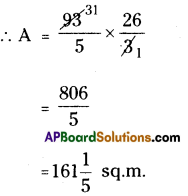
Question 9.
What number should [latex]-\frac{33}{16}[/latex] be divided by to get [latex]-\frac{11}{4}[/latex]
Solution:
Let the dividing number be ‘x’ say.
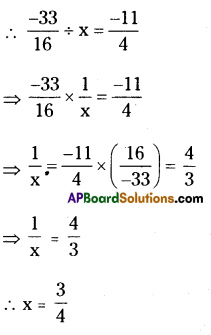
![]()
Question 10.
If 36 trousers of equal sizes can be stitched with 64 meters of cloth. What is the length of the cloth required for each trouser?
Solution:
36 trousers of equal sizes can he stitched with 64 mts of cloth, then the length of the cloth ¡s required for each trouser
= 64 ÷ 36
= [latex]\frac{64}{36}=\frac{16}{9}[/latex] = 1 [latex]\frac{7}{9}[/latex]
![]()
Question 11.
When the repeating decimal 0.363636 …. is written in simplest fractional form[latex]\frac{p}{q}[/latex] , find the sum p+ q.
Solution:
x = 0.363636………………………….. (1)
Here periodicity is ‘2’. So, equation (1) should be multiplied both sides with 100.
⇒ 100 × x = 100 × 0.363636 …………..
100 x = 36.3636 ………..(2)
